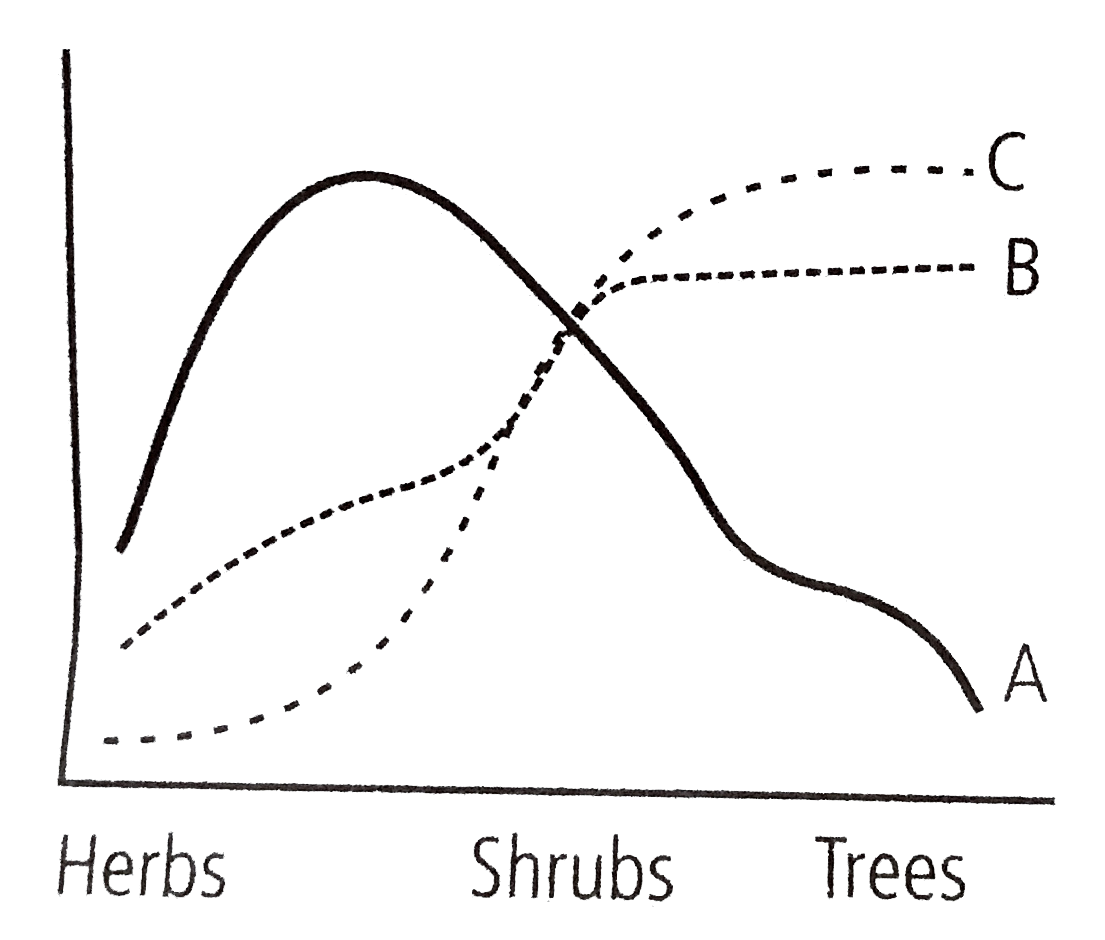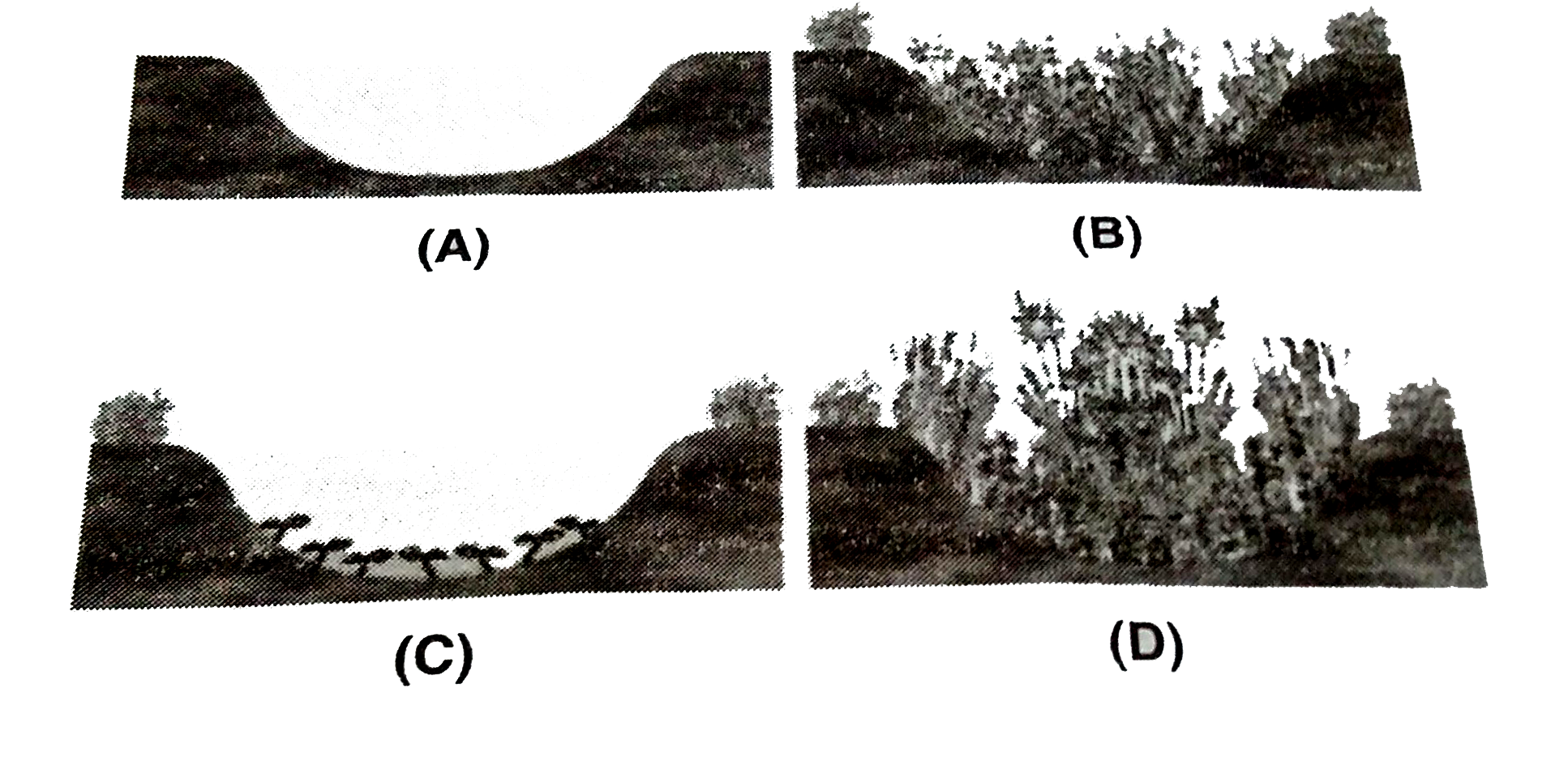Succession in a forest ecosystem is characterised by chnages in species diversity , biomass and net primary productivity as shwon in the graph below, identify curves A,B and C.

A: biomass B: net primary productivity C: species diversity
A: species diversity B: net primary productivity C: biomass
A: net primary productivity B: biomass C: species diversity
A: net primary productivity B: species diversity C: biomass
The correct Answer is:D
Biotic or ecological succession is the natural development of a series of biotic communities at the same, site, one after the other till a climax community develops which does not change further because it is in perfect harmony with the environment of the area. The change is orderly and sequential. At the end of biotic succession, i.e., when climax community has formed, the biomass has reached to the highest of all biotic stages, diversity has grown higher niches are many and specialised. However productivity has decreased as respiratory consumption has increased in the climax community.
Topper's Solved these Questions
Similar Questions
Select the correct combination of statements regarding the characteristics of productivity :
I. The rate of biomass production is called productivity and is expressed in terms of kcal m−2
II. Gross primary productivity is rate of production of biomass during photosynthesis
II. Gross primary productivity minus respiration loss is called net primary productivity
IV. Primary productivity depends only on the plant species inhabiting a particular area.
The correct statements areView SolutionIdentify true or false statements. Correct each false statement to make it true.
(i) Number of species in a community really matter to the functioning of the ecosystem.
(ii) David Tilman proved that decreased diversity contributed to higher productivity.
(iii) Rich biodiversity is not essential for ecosystem health but required for survival of human race of earth.
(iv) Species which are dangerously harmful beings and their interests can be thought of deliberate extinction.View Solution
Knowledge Check
- Question 1 - Select One
Which of the following statements is 1 are false?
I. In ecosystem food webs are found.
II Dry weight is chosen for expressing the biomass of a species. It is to avoid variation in weight due to seasonal moisture differences in the biomass.
III. Biogeochemical cycles occurs in Ecosystems.
IV. Photosynthesis and respiration are central to carbon cycle.
V. Atmosphere contains about 1% of total carbon.
VI. Rapid deforestation and massive burning of fossil fuel for energy and transport increased the rate of CO2 release into the atmosphere causing green house effect.
VII. The products of ecosystem processes are named as ecosystem services.
Vlll. Healthy ecosystems are base for a wide range of environmental services but not for economic growth.
IX. Healthy forest ecosystems not mitigate droughts.
X Robert Constanza et al have tried to put price tags on nature’s life support services.
XI. A. G. Transley coined the term Ecosystem
XII. The open ocean and tropical rain forest are the two largest contributes to Earth’s net primary productivity. Both have high rates of net primary productivity and both cover huge surface area of the Earth.AI, III, V, VIIBVIII and lXCII, IV, VI, XDXI, XII - Question 2 - Select One
Diagrammatic representation first four stages of primary succession is given below. Correctly identify A, B, C and D:
 AA - Phytoplankton, B - Reed-swamp stage, C - Submerged plant stage, D - Marsh-meadow stageBA - Reed swamp stage, B - Phytoplankton, C - Submerged plant stage, D - Marsh-meadow stage,CA - Reed-swamp stage, B - Marsh-meadow stage, C - Reed-swamp stage, D - Submerged plant stageDA - Marsh-meadow stage, B - Phytoplankton, C - Reed-swamp stage, D - Submerged plant stage
AA - Phytoplankton, B - Reed-swamp stage, C - Submerged plant stage, D - Marsh-meadow stageBA - Reed swamp stage, B - Phytoplankton, C - Submerged plant stage, D - Marsh-meadow stage,CA - Reed-swamp stage, B - Marsh-meadow stage, C - Reed-swamp stage, D - Submerged plant stageDA - Marsh-meadow stage, B - Phytoplankton, C - Reed-swamp stage, D - Submerged plant stage - Question 3 - Select One
If A =Gross primary productivity, B =Net primary productivity and C= Respiration losses, then what will be the correct relation between them?
AA+B=CBA+B+C=1CA-C=BDB-C=A
(a) What is "population" according to you as a biology student ?
(b) "The size of a population for any species is not a static parameter." Justify the statement with specific reference to fluctuations in the population density of a region in a given periods of time.
OR
(a ) What is hydrarch succession ?
(b) Compare the pioneer species and climax communities of hydrarch and xerarch succession respectively.
(c) List the factors upon which the type of invading pioneer species depend in secondary hydrarch succession. Why is the rate of this succession faster than that of primary succession ?View SolutionWhich one has the maximum biomass
Or
Which part of the world has a high diversity of organisms
Or
Which one of the following ecosystem types has the highest annual net preimary productivity.
Or
Presence of plants arranged into well defined vertical layers depending on their height can be seen best inView SolutionGo through the following statements.
A. Primary productivity of all ecosystem is a constant.
B. The annual net primary productivity of the whole of the biosphere is 17 million tons (dry weight) of organic matter.
C. Net primary productivity is the amount of biomass available for consumption by carnivores.
D. . Secondary productivity is defined as the rate of formation of new organic matter by decomposers.
E. Primary productivity depends on the plant species inhabiting a particular area. Which of the above statements about productivity is true?View SolutionSelect the correct combination of statements regarding the characteristics of productivity :
I. The rate of biomass production is called productivity and is expressed in terms of kcal m−2
II. Gross primary productivity is rate of production of biomass during photosynthesis
II. Gross primary productivity minus respiration loss is called net primary productivity
IV. Primary productivity depends only on the plant species inhabiting a particular area.
The correct statements areView SolutionConsider the following four statements (A-D) and select the correct option stating which ones are true (T) and which ones are False (F).
(A) Vertical distribution of different species occupying different levels in a community is called stratification.
(B) Net primary productivity minus respiration losses is the gross primary productivity.
(C) Rate of biomass production is called decompostion.
(D) Annual net primary productivity of oceans is 55 billion tons.View Solution
